Scott has completely refreshed its trail-riding, all-mountain slaying Genius model. Taking inspiration from the enclosed shock of its cross-country-focused Spark, the bike gets a 150mm makeover.
Two models of the new bike will be available, with a standard Genius and a more aggressive Genius Super Trail that’s designed with descending in mind. Both get 160mm forks, but the Super Trail (ST) has burlier components.
In keeping with the rest of Scott's full-suspension range, the new Genius will be offered in three different frame materials. These are a high-end full-carbon frame, a combined carbon front and alloy rear using a cheaper-grade carbon, and a full-alloy bike.
All levels of frame construction enjoy the same features – geometry, kinematics and integration.
As such, the Genius is effectively an extension of the Spark family, which now also features a Super Trail version, meaning there’s a combined five levels of Spark and Genius bikes in the Scott range, from cross-country race bikes to almost enduro readiness.
Scott’s design philosophy for these two bikes is dubbed ‘Simplexity’ – bikes that look simple from the outside, with their enclosed shock and internal cables, but are complex on the inside in terms of the technology used.
There are more details below, but Scott’s TwinLoc remains on the Genius and Genius ST, though in different guises.
This system gives the suspension three modes – Climb, Ramp Control and Descend.
Scott's goal has been to retain efficiency and versatility, while improving capability downhill.

Scott Genius frame details
Scott offers three different frame combinations on this latest-generation Genius. The full-carbon frames are constructed from a lightweight, high-modulus HMX carbon.
Slightly cheaper are the Hybrid frames, which use a cheaper HMF carbon and Alloy 6061 rear triangle.
Finally, full-alloy bikes use this same metal across front and rear portions of the frame.
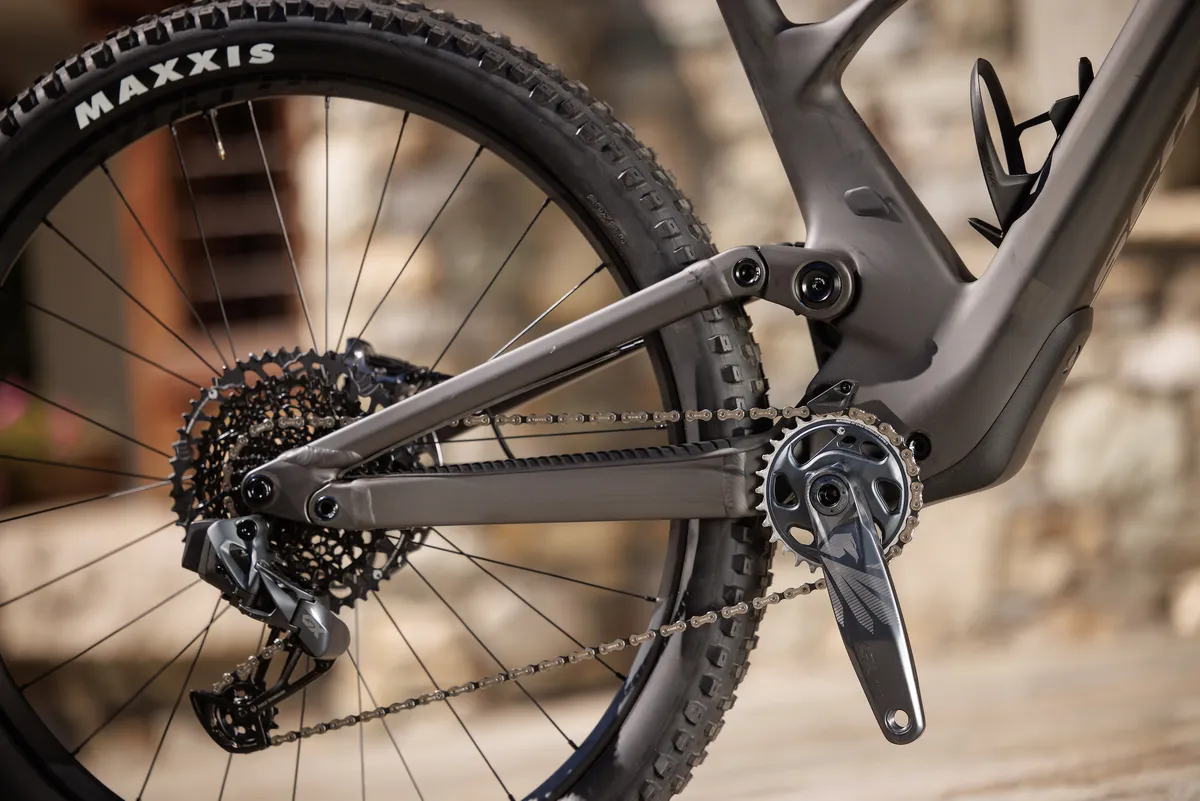
The carbon frame is made from 677 carbon pieces, with 55 areas of the frame being heavily analysed for optimum layup and performance.
A size-medium, full-carbon HMX frame is said to weigh 2,295g including hardware but no shock. The cheaper HMF frames are 500g heavier.
Each alloy frame is constructed from 30 different pieces of aluminium, each one designed individually, rather than taken off the shelf, or borrowed from elsewhere.
The frame uses Scott's Integrated Suspension Technology. A link compresses the shock, which is housed internally in the frame. This link uses large bearings, and a splined three-piece construction, with a grub screw pre-tensioning the splines to prevent knocking and wear.

The design is said to help isolate the shock from lateral forces, while encasing it in the carbon or alloy structure protects it from the elements, which should improve reliability and longevity. It also lowers the bike's centre of mass, which Scott claims aids handling and stability.
This dog-leg shaped link is built from a strong 7075 alloy.
Internal architecture
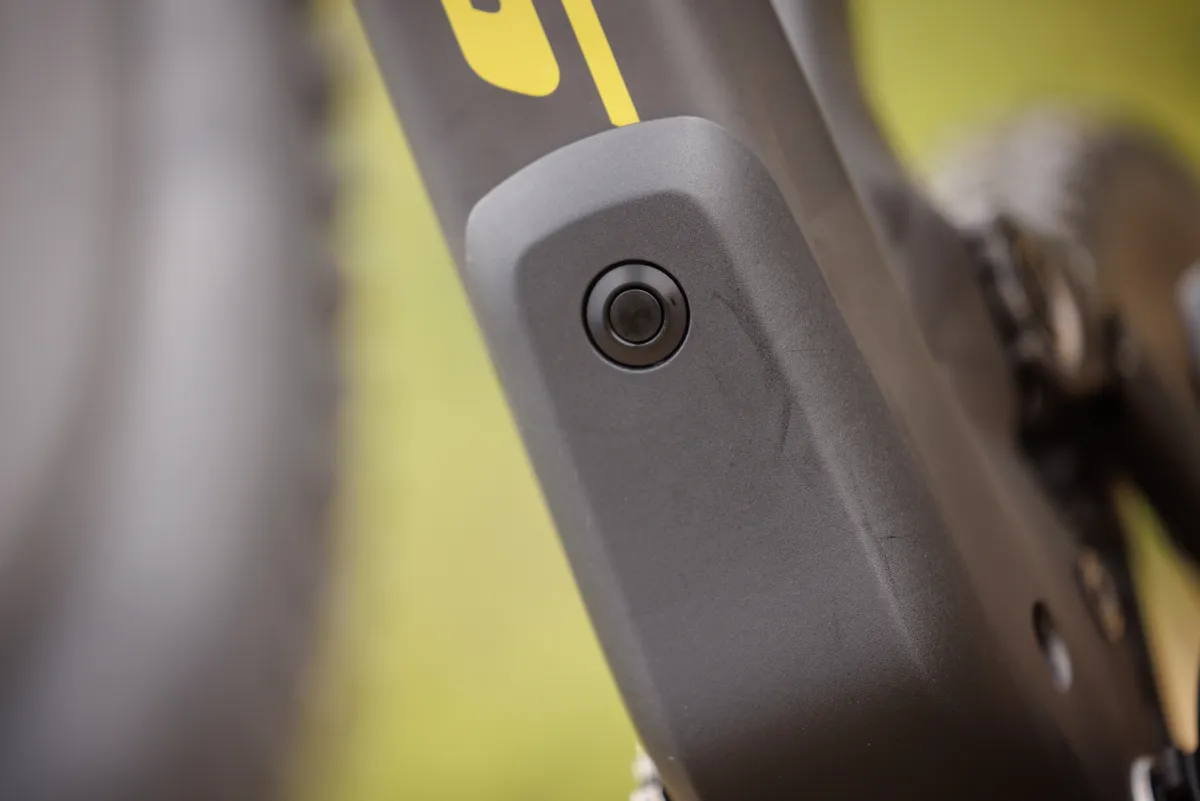
The large structure surrounding the shock helps with frame stiffness in the bottom bracket area, lowers the centre of gravity and gives ample room for a water bottle in the main triangle.
The shock’s housing is said to be big enough to allow for changes in shock architecture down the line. So, if shock bodies get bigger, there should still be room without requiring a redevelopment of the frame.
At the bottom of the frame is the door to access the shock’s adjustment dials and air valve. Opening the door is done via pressing a button, which releases a pin. The inside surface of the door shows the cable routing and gives a place to write shock settings.
Surrounding the main pivot of this link is a sag meter. A pointer is pushed round when the suspension compresses, but doesn’t return when the bike is unweighted. A scale printed on the link shows your percentage sag, within a recommended 25 to 35 per cent window.
The shock can be removed via bolts accessible on the outside of the frame, with rubble plugs keeping everything clean. All the suspension pivots can be removed with a Torx 30 key. The rear axle’s removable lever integrates a T30, T25 and 6mm hex bolt.
Internally, cables run as close to the pivots as possible, which reduces the amount they’re pulled during the suspension’s compression cycle. This, in turn, reduces wear and the chance of ghost shifting, where mechanical gears mis-shift.
At the front, adding to the integrated nature of the bike, is Syncros’ internal cable-routing headset, which enables the brake and gear hoses to be routed through the headset, giving an incredibly clean look.
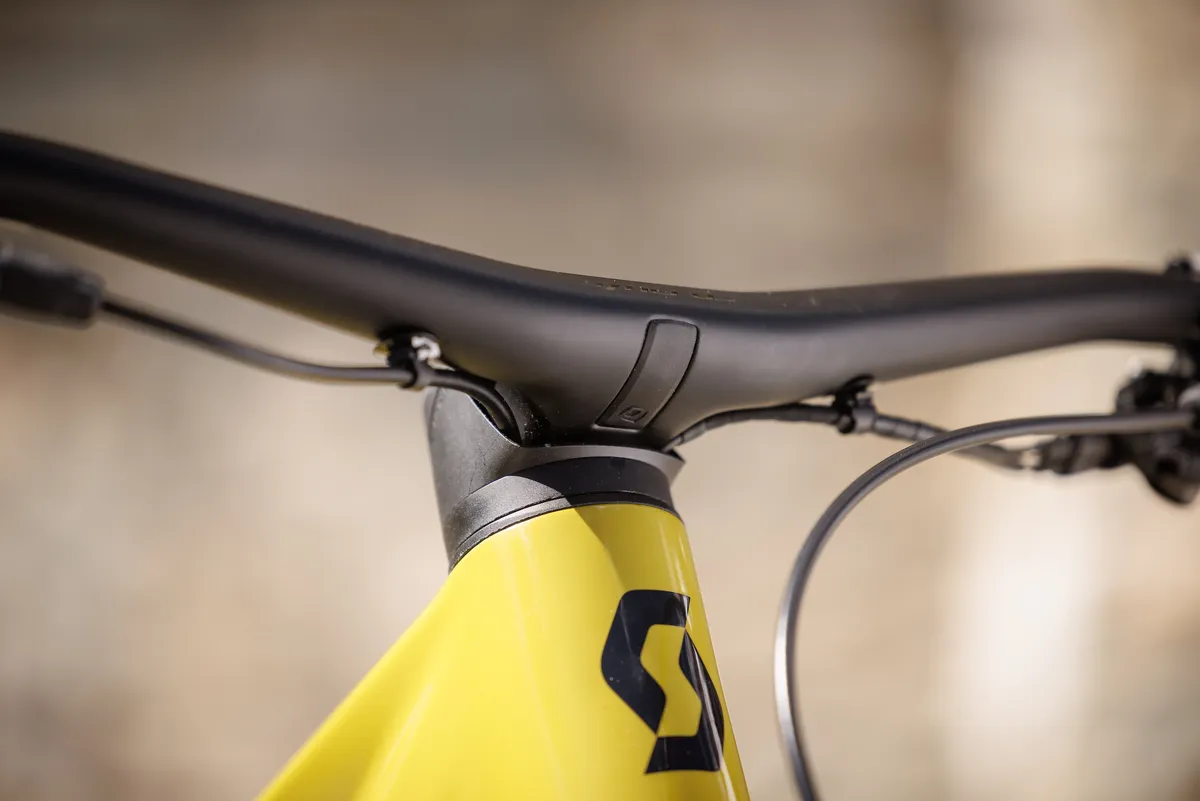
Scott Genius geometry details
The Genius has up-to-date, modern trail geometry, with a long, low and slack attitude.
| Size | Small | Medium | Large | Extra Large |
|---|---|---|---|---|
| Head tube length (mm) | 90 | 100 | 120 | 135 |
| Head angle (slack, degrees) | 63.9 | 63.9 | 63.9 | 63.9 |
| Top tube length (mm) | 570 | 602 | 631 | 659 |
| Standover (mm) | 729 | 739 | 754 | 769 |
| BB height (mm) | 432.5 | 432.5 | 432.5 | 432.5 |
| Wheelbase (mm) | 1,195 | 1,229 | 1,263 | 1,294 |
| Seat angle (degrees) | 77 | 77 | 77 | 77 |
| Chainstay length (mm) | 440 | 440 | 440 | 440 |
| Reach (mm) | 430 | 460 | 485 | 510 |
| Stack (mm) | 617 | 626 | 644 | 658 |
The headset cups can be rotated to give one degree of adjustment, either 64 or 65 degrees. Markings on the cups and frame ensure proper alignment.
Carbon frames are shipped with an additional headset that gives a 64.5-degree head angle. The Genius comes set up with a 65-degree head angle, while the Genius ST will be 64 degrees.
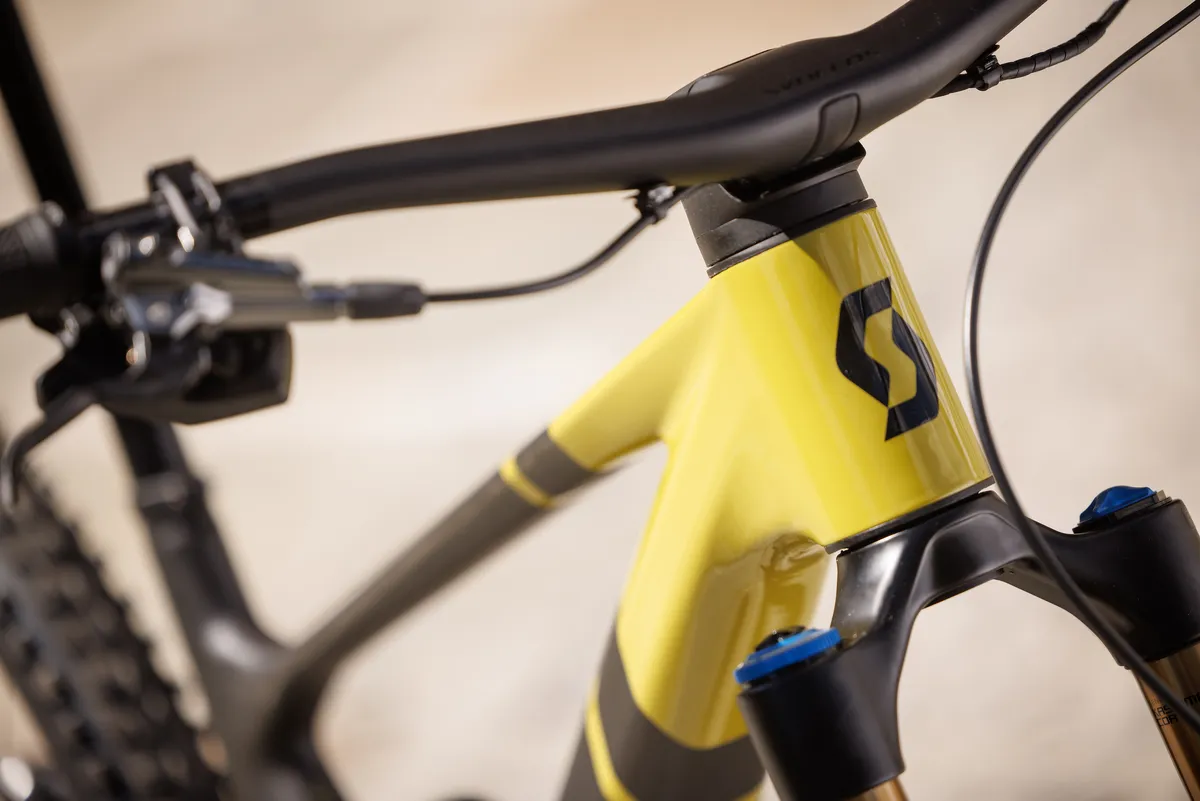
Compared to the outgoing model, this new Genius is two degrees steeper at the seat angle, 20mm longer in reach and half a degree slacker.
Scott Genius suspension details
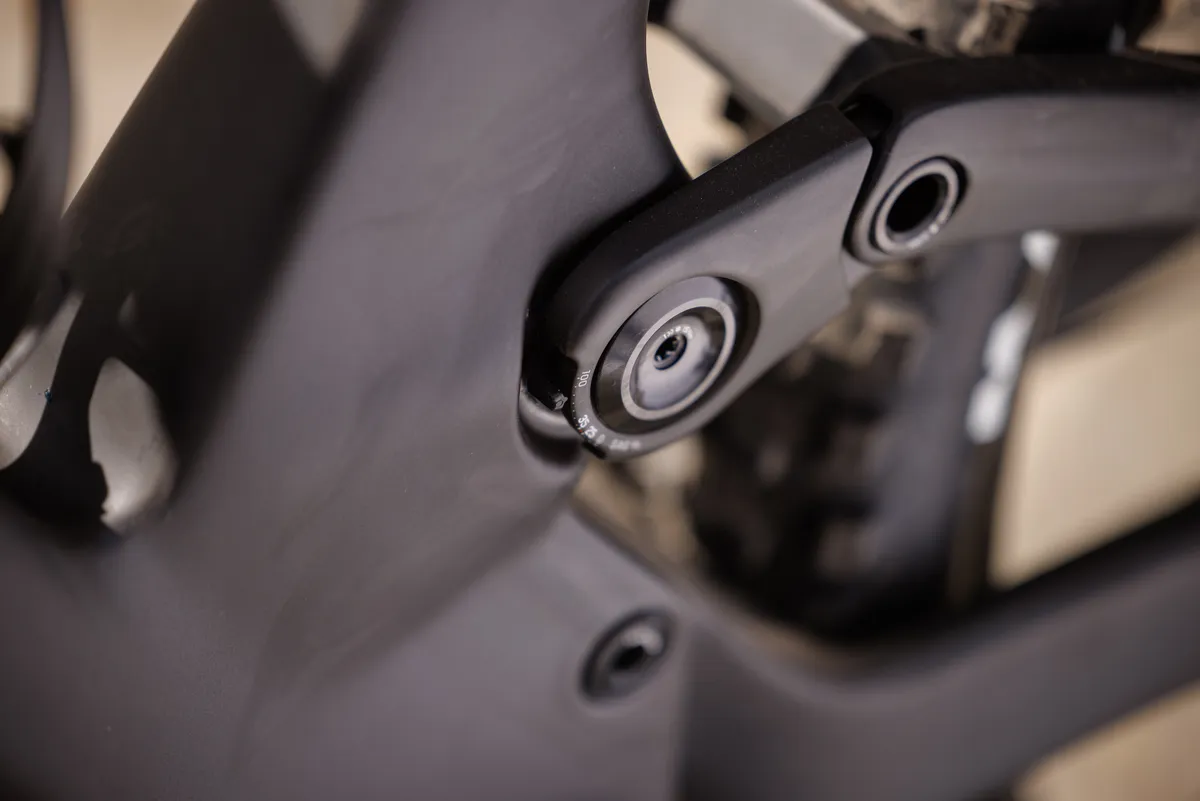
TwinLoc is Scott’s system of altering the shock’s air spring and damping characteristics on the fly, via a three-position bar-mounted lever system. This lever system ads a third lever to operate a cable-actuated dropper post.
The Genius and the Genius ST have slightly different systems.
Both use Fox Nude shocks, with the Genius receiving a Nude version of a single-can air shock. The ST receives a Nude version of the new Float X shock.
Both also offer Climb, Ramp Control and Descend modes. In Ramp Control mode, the size of the air chamber is restricted, which effectively reduces travel to 60 per cent of the original, while also helping keep the suspension propped up, with less sag and thus a higher bottom bracket.
Genius bikes also integrate the TwinLoc with Fox’s FIT4 damper, offering three damping positions similar to those on the fork. The Genius ST bikes’ Fox 36 forks aren’t linked to the TwinLoc, enabling some models to use the top-end GRIP2 damper.
Scott Genius TwinLoc system
The standard Genius’ TwinLoc has a fully open Descend mode, where the shock is able to access a fully-open damper and an air spring that comprises two chambers.
In Ramp Control mode, a pin closes off the secondary air chamber and adds extra hydraulic damping.
In Climb mode, the secondary air chamber remains closed, and the damping circuit is also closed.
Scott Genius ST TwinLoc system

The Genius ST’s TwinLoc has a fully open Descend mode, where the shock is able to access the full range of the damper's adjustment (there's an accessible dial on the shock) and an air spring that comprises of two chambers.
In Ramp Control mode, a pin closes off the secondary air chamber, but the damping circuit is left as it is in the Descent mode.
In Climb mode, the secondary air chamber remains closed, and the damping circuit is also closed.
The Fox Float X Nude shock was designed specifically for this bike, with development taking as long as Scott took to design the bike itself.
The main difficulty was packaging all the features Scott wanted into the limited space.
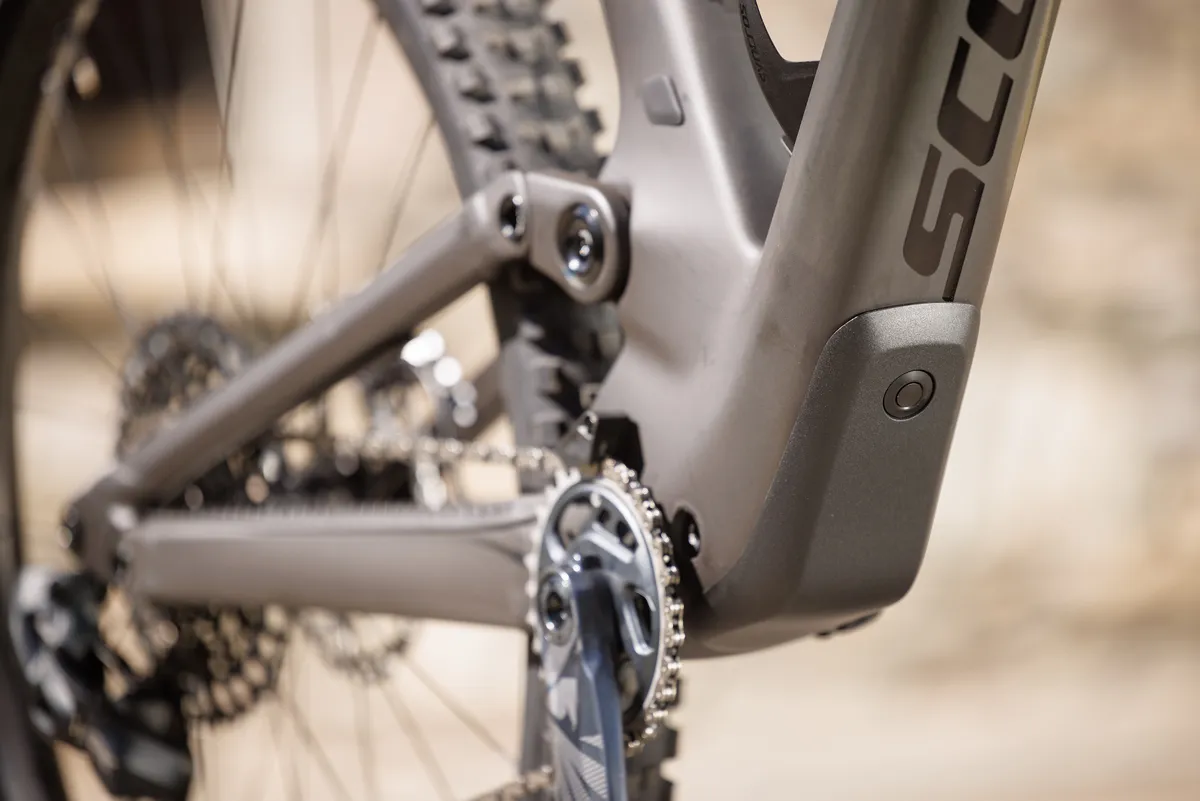
Scott Genius Kinematic details
The kinematics of the suspension remain similar to the bike launched for model year 2018, though there are some subtle tweaks.
Scott has worked with Fox to develop a custom tune for the shocks.
The suspension curve has been flattened a touch, but keeps the same 21 per cent progression overall. This means there’s more room for shock-tuning options, and gives a slightly more consistent feel to the suspension throughout its travel, according to Scott.

The anti-squat figure (that which determines how pedalling forces interact with the suspension – a.k.a. pedal bob) are over 100 per cent at the sag point in all gears, in order to prevent pedalling forces from compressing the shock. Values are said to have been raised by about 20 per cent over the previous version.
Scott Genius and Genius ST models
Ten models make up the Genius and Genius ST range. There are five Genius models, three Genius ST models and two women's specific Contessa models – a Contessa Genius and a Contessa Genius ST.
Claimed weights for the Genius bikes range from 12.8kg to 15.8kg (M), and the ST models come in at 15.8kg to 13.3kg (M).
Scott Genius 900 Ultimate specification and price details
- Frame: Carbon HMX
- Fork: Fox 36 Factory FIT4 160mm
- Shock: Fox Nude 5T Factory
- Drivetrain: SRAM XX1 AXS
- Brakes: Shimano XTR
- Wheels: Syncros Revelstoke 1.0S-30CL
- Tyres: Maxxis Dissector 29x2.6in
- Price: £11,999 / €11,999 / $11,999.99
Scott Genius 910 specification and price details
- Frame: Carbon HMF / alloy
- Fork: Fox 36 Performance Elite FIT4 160mm
- Shock: Fox Nude 5T
- Drivetrain: SRAM GX AXS
- Brakes: Shimano XT
- Wheels: Syncros Revelstoke 1.5 alloy
- Tyres: Maxxis Dissector 29x2.6in
- Price: £7,499 / €7,499 / $7,599.99
Scott Genius 920 specification and price details
- Frame: Carbon HMF / alloy
- Fork: Fox 36 Rhythm GRIP 160mm
- Shock: Fox Nude 5T
- Drivetrain: Shimano Deore/XT
- Brakes: Shimano Deore
- Wheels: Syncros X-30S rims, Formula hubs
- Tyres: Maxxis Dissector 29x2.6in tyres
- Price: £4,999 / €4,999 / $4,999.99
Scott Genius 930 specification and price details
- Frame: alloy
- Fork: Fox 36 Rhythm GRIP 160mm
- Shock: Fox Nude 5T
- Drivetrain: Shimano Deore/XT
- Brakes: SRAM DB8
- Wheels: Syncros X-30S rims, Formula hubs
- Tyres: Maxxis Dissector 29x2.6in tyres
- Price: £4,499 / €4,499 / $4,499.99
Scott Genius 940 specification and price details
- Frame: alloy
- Fork: Marzocchi Z2 150mm
- Shock: X-Fusion Nude 5 RLX
- Drivetrain: SRAM SX/NX
- Brakes: Shimano MT501
- Wheels: Syncros X-30S rims, Formula hubs
- Tyres: Maxxis Dissector 29x2.6in
- Price: £3,799 / €3,799 / $3,799.99
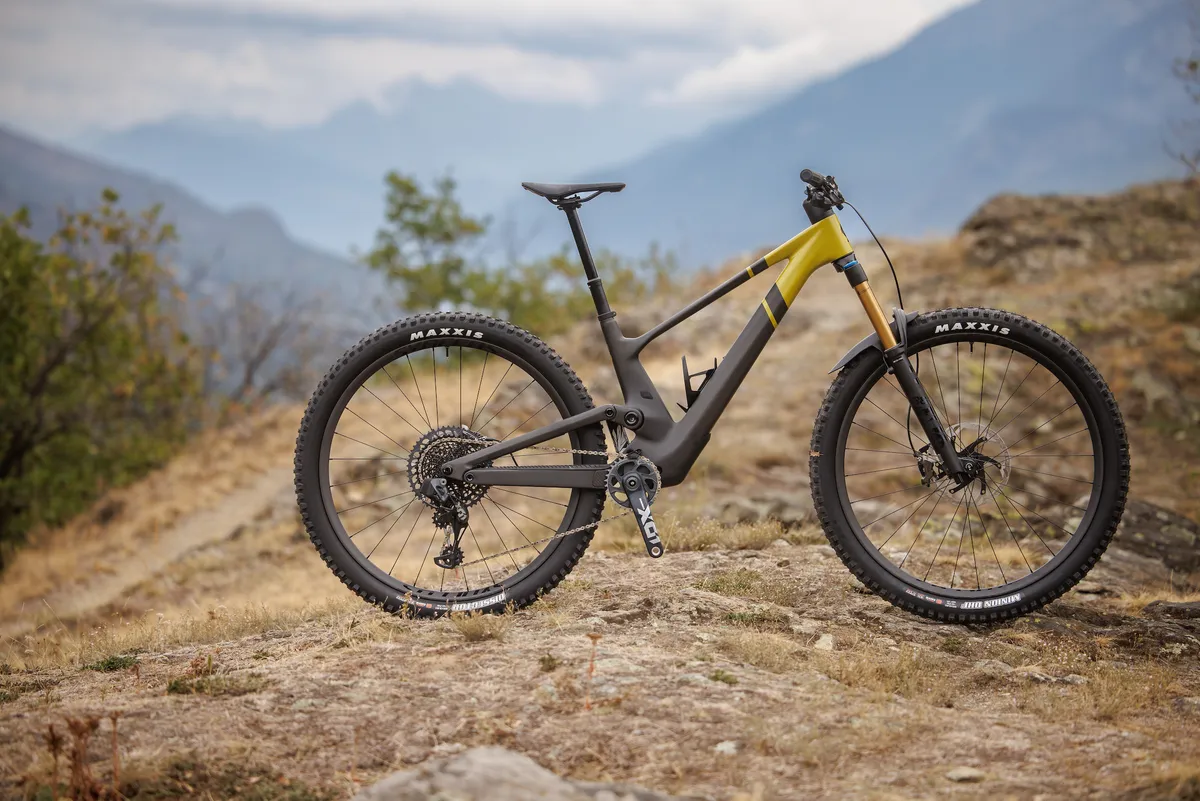
Scott Genius ST 900 Tuned specification and price details
- Frame: Carbon HMX
- Fork: Fox 36 Factory GRIP2 160mm fork
- Shock: Fox Float X Nude 5T Factory
- Drivetrain: SRAM X01 AXS
- Brakes: Shimano XTR
- Wheels: Syncros Revelstoke 1.0-30CL
- Tyres: Maxxis Minion DHF / Dissector 29x2.6in
- Price: £10,999 / €10,999 / $10,999.99
Scott Genius ST 910 specification and price details
- Frame: Carbon HMF / alloy
- Fork: Ohlins RXF36 m.2 Air 160mm
- Shock: Fox Float X Nude
- Drivetrain: SRAM GX AXS
- Brakes: Shimano XT
- Wheels: Syncros Revelstoke 2.0 alloy
- Tyres: Maxxis Minion DHF / Dissector 29x2.6in
- Price: £7,499 / €7,499 / $7.599.99
Scott Genius ST 920 specification and price details
- Frame: alloy
- Fork: RockShox Lyrik Rush RC 160mm
- Shock: Fox Float X Nude
- Drivetrain: SRAM SX/NX
- Brakes: SRAM DB8
- Wheels: Syncros X-30S rims, Formula hubs
- Tyres: Maxxis Minion DHF / Dissector 29x2.6in
- Price: £4,999 / €4,999 / $4,999.99
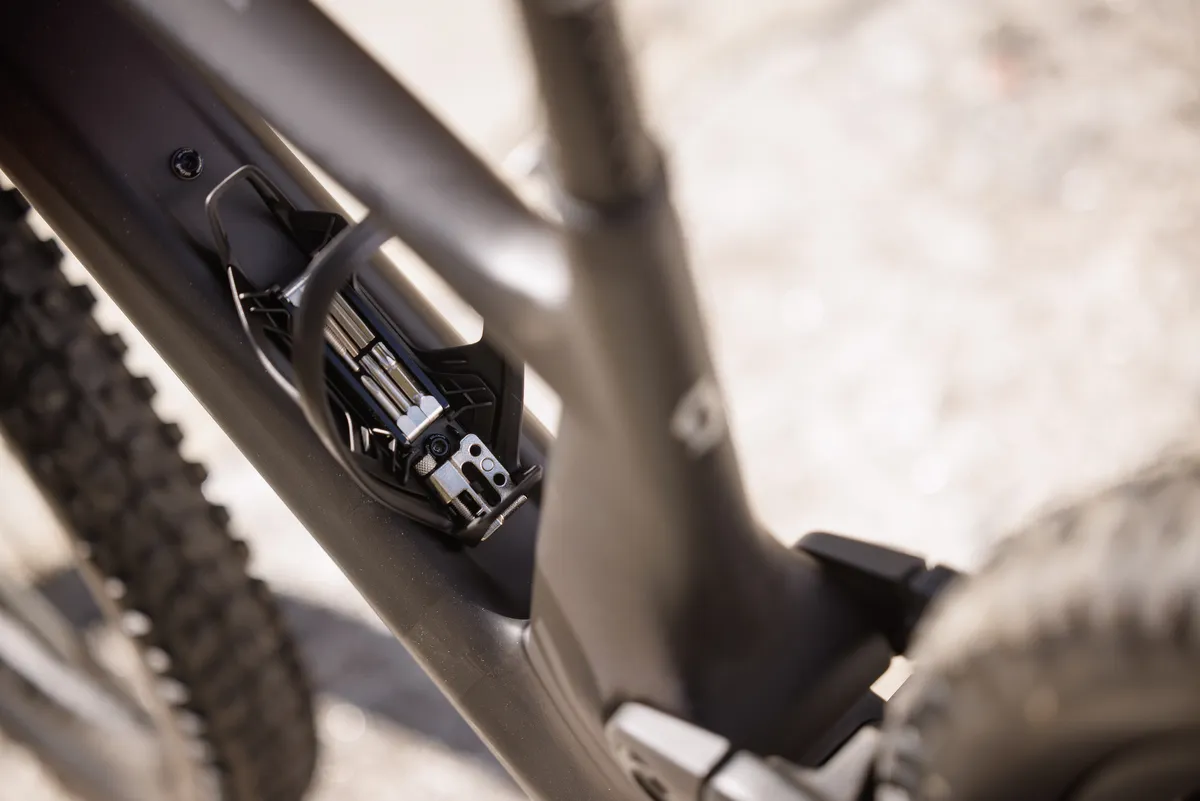
Scott Contessa Genius ST 910 specification and price details
- Frame: Carbon HMF / alloy
- Fork: Fox 36 Performance Elite 160mm
- Shock: Fox Float X Nude
- Drivetrain: SRAM GX AXS
- Brakes: Shimano XT
- Wheels: Syncros Revelstoke 2.0 alloy
- Tyres: Maxxis Minion DHF / Dissector 29x2.6in
- Price: £7,499 / €7,499 / $7.599.99
Scott Contessa Genius 920 specification and price details
- Frame: Carbon HMF / alloy
- Fork: Fox 36 Rhythm GRIP 160mm
- Shock: Fox Nude 5T
- Drivetrain: Shimano Deore/XT
- Brakes;: Shimano Deore
- Wheels: Syncros X-30S rims, Formula hubs
- Tyres: Maxxis Dissector 29x2.6in
- Price: £4,999 / €4,999 / $4,999.99
